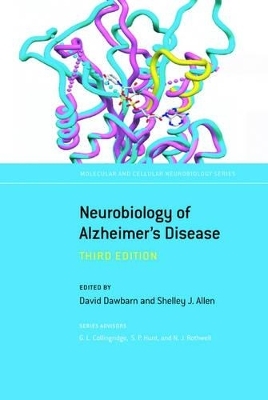
Neurobiology of Alzheimer's Disease
Oxford University Press (Verlag)
978-0-19-856661-8 (ISBN)
Alzheimer's disease is the most common form of dementia in the elderly; 450,000 people in the UK and 4.5 million people in the USA suffer with this disease. This 3rd edition of Neurobiology of Alzheimer's Disease gives a comprehensive and readable introduction to the disease, from molecular pathology to clinical practice.
The book is intended for readers new to the field, and it also covers an extensive range of themes for those with in-depth knowledge of Alzheimer's disease. It will therefore act either as an introduction to the whole field of neurodegeneration or it will help experienced researchers to access the latest research in specialist topics. Each chapter is written by eminent scientists leading their fields in neuropathology, clinical practice and molecular neurobiology; appendices detail disease-associated proteins, their sequences, familial mutations and known structures.
It will be essential reading for students interested in neurodegeneration and for researchers and clinicians, giving a coherent and cohesive approach to the whole area of research, and allowing access at different levels. For those in the pharmaceutical industry it describes the underlying molecular mechanisms involved in the pathogenesis of Alzheimer's disease and explains how current and potential therapeutics may work.
David Dawbarn obtained his PhD from the University of Bristol and then initiated his work on Alzheimer's disease (AD) at the Medical Research laboratories in Cambridge as a Research Fellow. He returned to Bristol to take up a lectureship investigating the molecular pathology of Alzheimer's disease and developing new therapies. His interests are in nerve growth factor (NGF) and Alzheimer's disease; his early work described the distribution of NGF receptors in the brain, showing their specific localisation on cholinergic neurons. The identity of the NGF binding site on its receptor was then determined. The domain was made as a recombinant protein, crystallised and its structure solved. The coordinates of the structure are currently being used for the development of small molecule therapeutics for the treatment of Alzheimer's disease. Shelley Allen obtained her PhD at the Institute of Neurology in London, and her work in the early eighties with David Bowen started her interest in the cholinergic changes in Alzheimer brain. Later at Bristol she investigated the characterisation of human cholinergic basal nucleus in terms of the nerve growth factor (NGF) receptor. She has continued this work on the neurotrophins and the possibility of a neurotrophin related therapeutic for Alzheimer's disease. In addition she is especially interested in the influence of cholinergic activity on Alzheimer-associated pathogenic processes. Her work recently has also shown variously the synaptic loss associated with the E4 allele of apolipoprotein E in normal individuals and the increase in BACE activity in sporadic Alzheimer's disease.
1. Alzheimer's disease: a hundred years of investigation ; 2. The neuropathology of Alzheimer's disease ; 3. Molecular genetics of Alzheimer's disease ; 4. Biology and molecular neuropathology of beta-amyloid protein ; 5. The molecular basis of tau protein pathology: role of abnormal hyperphosphorylation ; 6. Protein misfolding, aggregation and fibril formation: common features of cerebral and non-cerebral amyloidosis ; 7. Apolipoprotein E, amyloid beta-peptide and Alzheimer's disease ; 8. Presenilins ; 9. Multiple transgenic mouse models for Alzheimer's disease ; 10. Inflammation and Alzheimer's disease ; 11. Cellular targets of amyloid beta-peptide: potential roles in neuronal cell stress and toxicity ; 12. Alzheimer's disease as a neurotransmitter disease ; 13. NGF family of neurotrophins and their receptors: early involvement in the progression of Alzheimer's disease ; 14. Clinical assessment of Alzheimer's disease ; 15. Molecular and biological markers for Alzheimer's disease ; 16. Current pharmacological approaches to treating Alzheimer's disease ; 17. Amyloid-based therapies ; 18. Future directions: the A-beta amyloid pathway as the target for diagnosing, preventing or treating Alzheimer's disease
| Erscheint lt. Verlag | 1.6.2007 |
|---|---|
| Reihe/Serie | Molecular and Cellular Neurobiology Series |
| Zusatzinfo | numerous halftones; 12pp colour plates; numerous figures/tables |
| Verlagsort | Oxford |
| Sprache | englisch |
| Maße | 178 x 254 mm |
| Gewicht | 997 g |
| Themenwelt | Medizin / Pharmazie ► Medizinische Fachgebiete ► Geriatrie |
| Medizin / Pharmazie ► Medizinische Fachgebiete ► Neurologie | |
| Naturwissenschaften ► Biologie ► Humanbiologie | |
| Naturwissenschaften ► Biologie ► Zoologie | |
| ISBN-10 | 0-19-856661-1 / 0198566611 |
| ISBN-13 | 978-0-19-856661-8 / 9780198566618 |
| Zustand | Neuware |
| Haben Sie eine Frage zum Produkt? |
aus dem Bereich


